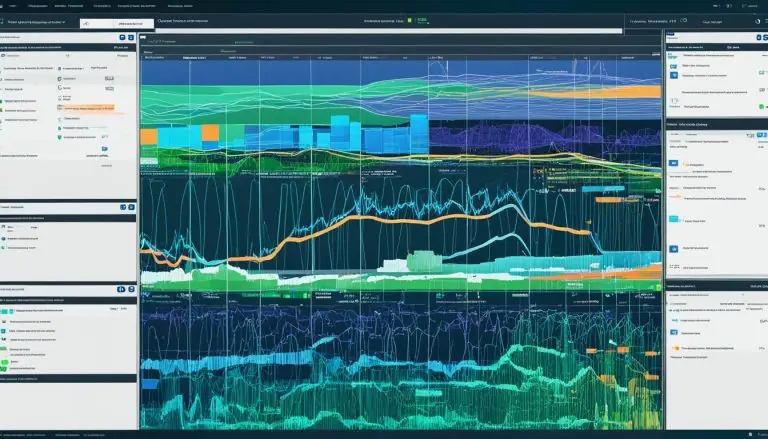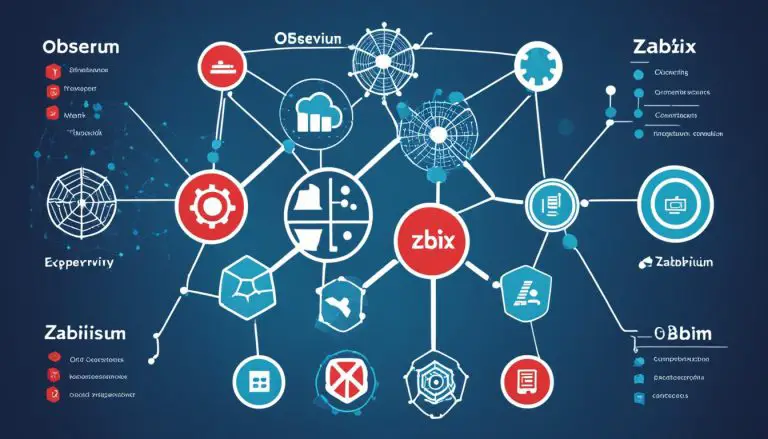Cacti vs. LibreNMS: Network Monitoring Compared
Are you searching for the perfect network monitoring tool but unsure whether to choose Cacti or LibreNMS? With so many open-source options available, it can be challenging to determine which one suits your specific needs. That’s why I’m here to help you make an informed decision.
In this article, we will compare and analyze Cacti and LibreNMS, two popular network monitoring tools, to provide you with valuable insights. Whether you’re looking for network performance monitoring, open-source monitoring software, or reliable network management solutions, this comparison will guide you in selecting the right tool for your network infrastructure.
Key Takeaways
- Understand the key features of Cacti and LibreNMS
- Evaluate the ease of use and installation process for both tools
- Explore the availability of community support and documentation
- Analyze integration and extensibility options
- Consider the performance and scalability of each tool
Key Features of Cacti
Cacti is a powerful network monitoring tool that offers a wide range of features to ensure efficient network management. From bandwidth monitoring to server monitoring, Cacti provides comprehensive solutions to meet the diverse needs of businesses. Let’s explore some of its key features:
- Bandwidth Monitoring: Cacti allows you to monitor bandwidth usage across your network, providing valuable insights into traffic patterns and resource allocation.
- Baseline Manager: With Cacti’s baseline manager, you can establish performance baselines to track network performance against established benchmarks.
- Diagnostic Tools: Cacti offers diagnostic tools to troubleshoot network issues, helping you quickly identify and resolve problems.
- IP Address Monitoring: Monitor IP addresses and track their usage to ensure efficient network resource allocation.
- Internet Usage Monitoring: Gain visibility into internet usage patterns, helping you optimize bandwidth allocation and ensure optimal network performance.
- Real-Time Analytics: Cacti provides real-time analytics to give you instant insights into your network’s performance, enabling proactive decision-making.
- Resource Management: Effectively manage network resources by monitoring CPU, memory, and disk usage, optimizing performance and avoiding bottlenecks.
- SLA Monitoring: Cacti offers SLA monitoring capabilities, helping you track and meet service level agreements, ensuring customer satisfaction.
- Server Monitoring: Monitor server health and performance metrics to identify potential issues and prevent service disruptions.
- Uptime Monitoring: Ensure high availability of your network by monitoring uptime, receiving alerts for any downtime, and taking immediate action to minimize disruptions.
- Web Traffic Reporting: Cacti provides comprehensive web traffic reporting, allowing you to analyze and optimize web traffic patterns for better performance.
“Cacti’s extensive feature set empowers businesses of all sizes to effectively monitor and manage their network infrastructure. From monitoring bandwidth usage and server performance to analyzing web traffic and ensuring uptime, Cacti offers a comprehensive solution for effective network monitoring.”
To visually represent the data and insights generated by Cacti, consider utilizing the following chart:
Key Features of LibreNMS
LibreNMS offers a range of key features that make it a powerful and flexible network monitoring solution.
- Automatic Discovery: LibreNMS automatically discovers and adds devices to your network for monitoring, saving you time and effort.
- Alerts with a Rule Engine: With LibreNMS, you can set up alerts based on specific rules and conditions, allowing you to proactively address any network issues.
- Syslog Integration: The syslog integration feature in LibreNMS allows you to collect and analyze syslog messages from your network devices, enabling you to gain valuable insights into your network’s health.
- Flexible Installation Options: LibreNMS offers flexible installation options, including Linux distro packages, virtual or physical appliances. This ensures compatibility and ease of deployment for various network environments.
- Customizable Maps and Dashboards: You can create custom maps and dashboards in LibreNMS to visualize your network’s performance and status in a way that suits your specific needs.
- Performance Monitoring using Check Plugins: With a variety of check plugins, LibreNMS allows you to monitor network performance metrics, such as latency, packet loss, and bandwidth utilization, providing you with valuable insights into your network’s performance.
- Integration with Other Systems like Grafana: LibreNMS seamlessly integrates with other systems like Grafana, enabling you to combine data from various sources and create comprehensive visualizations and reports for your network monitoring.
“LibreNMS’s automatic discovery and syslog integration features have been incredibly helpful in managing our network. We can quickly identify and resolve any issues, ensuring our network runs smoothly.” –
These features highlight LibreNMS’s capabilities in providing efficient network monitoring and management solutions. Whether you need real-time alerts, customizable dashboards, or seamless integration options, LibreNMS has you covered.
Ease of Use and Installation
When it comes to network monitoring tools, ease of use and installation are crucial factors to consider. In this section, I will discuss the installation process and usability of both Cacti and LibreNMS.
Cacti
Cacti is renowned for its user-friendly interface and straightforward installation process. Whether you are a beginner or an experienced user, Cacti makes it easy for anyone to get started with network monitoring. The installation is compatible with various operating systems, making it versatile for different environments. The simplicity of Cacti’s installation process means less time spent on setup and more time focused on monitoring your network’s performance.
LibreNMS
LibreNMS offers multiple installation options to cater to different user preferences. While slightly more technical expertise may be required compared to Cacti, LibreNMS provides comprehensive documentation that guides users through each step of the installation process. Whether you choose a Linux distro package, virtual or physical appliance, you’ll find clear instructions to help you set up LibreNMS effectively. The availability of installation options ensures flexibility and adaptability to your specific network monitoring needs.
Choosing between Cacti and LibreNMS in terms of ease of use and installation depends on your level of technical proficiency and the amount of time you can allocate to the setup process. Cacti’s user-friendly interface and compatibility with various operating systems make it an excellent choice for those seeking a quick and easy installation. On the other hand, LibreNMS’s multiple installation options and comprehensive documentation cater to those who prefer more customization and are willing to invest slightly more time in the initial setup.
To illustrate the installation process visually, take a look at the screenshot below:
Overall, both Cacti and LibreNMS offer user-friendly interfaces and installation processes, each with its own unique advantages. Consider your technical proficiency and the level of customization you require when deciding which network monitoring tool is best suited to your needs.
Community Support and Documentation
In addition to their extensive features, both Cacti and LibreNMS are supported by vibrant communities who provide valuable assistance and resources to users.
Cacti Community Support
Cacti boasts an active and supportive community of users and developers. If you encounter any issues or have questions about Cacti’s functionality, you can turn to the dedicated Cacti forum for help. The forum serves as a hub where users can seek guidance, share tips and tricks, and engage in discussions related to Cacti and network monitoring. With the support of this community, you can effectively resolve any challenges you may encounter while using Cacti.
Cacti Documentation
Accompanying Cacti’s community support is the official Cacti documentation. This comprehensive resource provides detailed instructions and guidelines on how to make the most of Cacti’s capabilities. Whether you need assistance with installation, configuration, or troubleshooting, the Cacti documentation offers step-by-step guidance and best practices. By referring to this documentation, you can ensure a smooth experience while using Cacti for your network monitoring needs.
LibreNMS Community Support
Similar to Cacti, LibreNMS also benefits from an engaged and responsive community. With a strong community support system in place, LibreNMS users can rely on fellow enthusiasts and experts for assistance. Whether you have questions, need advice, or want to discuss specific aspects of LibreNMS, the community is there to lend a helping hand. The collective knowledge and experience within the LibreNMS community make it a valuable resource for users seeking guidance or feedback.
LibreNMS Documentation
To complement its community support, LibreNMS provides comprehensive documentation to empower users with the necessary knowledge to effectively utilize the platform. The LibreNMS documentation includes user guides, tutorials, and a catalog of check plugins to help you navigate the tool’s features and functionality. Whether you are new to LibreNMS or looking to explore its advanced capabilities, the documentation will serve as a valuable reference, providing you with the information needed to troubleshoot and optimize your network monitoring activities.

Integration and Extensibility
Both Cacti and LibreNMS offer powerful integration capabilities, allowing users to seamlessly connect these network monitoring tools with other systems and tools.
Cacti has a dedicated marketplace that provides a wide range of additional plugins and extensions. These plugins enhance Cacti’s functionality, allowing users to customize and tailor the tool to their specific network monitoring needs. Whether you’re looking to integrate with third-party applications, add new visualizations, or extend monitoring capabilities, the Cacti marketplace offers a diverse selection of options to choose from.
On the other hand, LibreNMS offers built-in connectors for popular systems like Grafana, enabling users to easily integrate and combine the power of LibreNMS’s network monitoring capabilities with other visualization and analytics tools. Additionally, LibreNMS provides APIs that allow for custom integrations, giving users the flexibility to connect with any system or tool that supports APIs.
Both Cacti and LibreNMS prioritize extensibility, ensuring that these tools can adapt to diverse network monitoring requirements. Whether you need to integrate with existing systems, extend functionality through plugins, or utilize APIs for custom integrations, Cacti and LibreNMS offer the flexibility and extensibility to meet your network monitoring needs.
Why Integration and Extensibility Matter
Integration and extensibility are crucial aspects of network monitoring tools. By seamlessly integrating with other systems and tools, organizations can achieve a unified view of their network infrastructure, consolidate data from multiple sources, and gain deeper insights into network performance and health.
Additionally, extensibility allows users to customize and extend the core functionalities of their chosen network monitoring tool to suit their specific needs. This flexibility enables businesses to adapt the tool to their unique network monitoring requirements without being limited by the out-of-the-box features.
Whether you choose Cacti or LibreNMS, the integration options and extensibility provided by these tools ensure that you can leverage existing infrastructure, maximize the value of your network monitoring investments, and achieve more comprehensive network visibility and management.
Performance and Scalability
Cacti and LibreNMS are powerful network monitoring tools that are designed to handle large-scale network monitoring requirements. Both tools have a strong focus on performance and scalability, ensuring that they can effectively monitor and manage networks of various sizes.
Cacti Performance
Cacti is known for its reliable performance, even when monitoring a significant number of devices. Its robust architecture allows it to efficiently collect and process network data, providing real-time insights into network performance. Whether you are monitoring a small network or a large enterprise infrastructure, Cacti’s performance remains consistent and responsive.
LibreNMS Performance
Similar to Cacti, LibreNMS is designed to handle demanding network environments with ease. It utilizes efficient data collection mechanisms and optimized database queries to ensure fast and accurate performance monitoring. Regardless of the size and complexity of your network, LibreNMS can scale to meet your monitoring needs and provide you with valuable insights into your network performance.
Both Cacti and LibreNMS offer exceptional performance and scalability. The choice between the two tools depends on the specific needs of your network infrastructure and the expected growth in the future. Consider factors such as the number of devices to be monitored, the frequency of data collection, and the complexity of your network architecture.
Ultimately, whether you choose Cacti or LibreNMS, you can be confident that you have a reliable and scalable network monitoring solution that will help you effectively manage and optimize your network performance.
Cost and Licensing
When it comes to choosing a network monitoring tool, cost and licensing are important factors to consider. Both Cacti and LibreNMS offer the advantage of being open-source software, which means they are available for free. This is particularly appealing for organizations looking to implement cost-effective solutions without the burden of licensing fees.
However, while the software itself is free, it is essential to consider other costs associated with implementing network monitoring solutions. Hardware costs, maintenance expenses, and ongoing support should be taken into account when evaluating the overall cost of using Cacti or LibreNMS.
Additionally, both Cacti and LibreNMS provide paid support options for businesses that require professional assistance and advanced features. These support options may come with an associated cost but offer the benefit of dedicated technical support and access to additional functionality.
Ultimately, organizations must carefully assess their budget and specific needs to determine the true cost of implementing network monitoring solutions. While the software itself is free, considering the cost of hardware, maintenance, and support is crucial in making an informed decision.
Choosing the Right Monitoring Tool
When deciding between Cacti and LibreNMS, it is essential to evaluate your network monitoring requirements, technical expertise, and future scalability needs. Both Cacti and LibreNMS offer a range of features for network monitoring, making it important to consider various factors that can influence your decision.
Ease of Use and Installation
One crucial aspect to consider is the ease of use and installation process. Cacti is known for its user-friendly interface and straightforward installation, which makes it accessible to users with minimal technical knowledge. On the other hand, LibreNMS offers multiple installation options but may require slightly more technical expertise compared to Cacti.
Community Support and Documentation
When facing challenges or seeking assistance, having a supportive community and comprehensive documentation is invaluable. With Cacti, you can rely on an active community of users and developers available through forums and dedicated documentation. Similarly, LibreNMS also boasts an engaged community and offers comprehensive documentation, including user guides and a catalog of check plugins.
Integration and Extensibility
Another aspect to consider is the integration options and extensibility of the monitoring tools. Cacti has a marketplace where additional plugins and extensions can enhance its functionality, providing users with more flexibility. In contrast, LibreNMS offers built-in connectors for systems like Grafana and provides APIs for custom integrations, allowing for seamless connectivity with other tools and systems.
Performance and Scalability
Scalability and performance are crucial factors, especially if you have a large-scale network infrastructure. Both Cacti and LibreNMS are designed to handle demanding network monitoring requirements. Cacti’s performance is known to be reliable, even with a significant number of monitored devices. Similarly, LibreNMS has the ability to scale and perform well in demanding network environments.
Cost and Licensing
Cost is an important consideration when implementing network monitoring solutions. Both Cacti and LibreNMS are open-source monitoring software and available for free without any licensing costs. However, it is important to consider other factors such as hardware costs, maintenance, and support requirements. Additionally, both tools offer paid support options for businesses that require professional assistance and advanced features.
Assessing these factors, such as ease of use, installation process, community support, integration options, performance, scalability, and cost, will help you make an informed decision on which tool best aligns with your network management objectives.
Continue reading to discover the conclusion and summary of the Cacti vs. LibreNMS comparison in the next section.
Conclusion
In conclusion, Cacti and LibreNMS are both robust network monitoring tools that offer a range of features and flexibility. Cacti stands out for its user-friendly interface and straightforward installation process, making it a popular choice for those seeking ease of use. On the other hand, LibreNMS excels in automatic discovery, advanced alerting options, and integration capabilities, offering greater customization and control for network monitoring.
When it comes to choosing between Cacti and LibreNMS, your decision should be based on your specific network monitoring needs and preferences. Consider factors such as the complexity of your network infrastructure, the level of technical expertise available, and your long-term network management strategy. It is recommended to test both tools in your environment to determine which one best suits your requirements.
Ultimately, whether you opt for Cacti or LibreNMS, you can be confident that you are selecting a reliable open-source network monitoring solution that will provide valuable insights into your network performance and ensure efficient management of your network infrastructure.
FAQ
What are the key features of Cacti?
What are the key features of LibreNMS?
How easy is it to use and install Cacti?
How easy is it to use and install LibreNMS?
Is there community support available for Cacti and LibreNMS?
Can Cacti and LibreNMS be integrated with other systems?
How well do Cacti and LibreNMS perform in demanding network environments?
Are there any licensing costs associated with using Cacti and LibreNMS?
How do I choose between Cacti and LibreNMS?
What is the conclusion of the Cacti vs. LibreNMS comparison?
- About the Author
- Latest Posts
Mark is a senior content editor at Text-Center.com and has more than 20 years of experience with linux and windows operating systems. He also writes for Biteno.com






